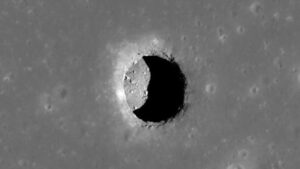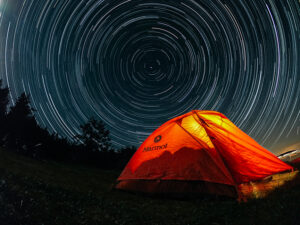Astrophysicists at the Kitt Peak National Observatory, near Tucson, Arizona, have just unveiled the largest map of the universe.
The advanced image includes more than 7.5 million galaxies beyond our own, and researchers say that’s just 10% of what they expect to capture over the five-year course of the DESI project.
Up to 40 million galaxies, an unknown number of interstitial events, and a monstrous array of cosmic objects are still out there, waiting for their 15 seconds of terrestrial fame.
Meet DESI

The Mayall Telescope (tallest telescope at right) is home to DESI, at Kitt Peak National Observatory near Tucson, Arizona. Photo: Marilyn Chung/Berkeley Lab
‘DESI’ is short for Dark Energy Spectroscopic Instrument, a 14-story-high 3D surveyor funded by the U.S. Department of Energy’s Berkeley National Laboratory. It has only been in commission for seven months and is installed adjacent to Kitt Peak’s four-metre telescope, which functions as DESI’s very literal eye.

This illustration of DESI in the telescope dome shows internal components, including the focal plane and corrector barrel (dark gray) at the top of the telescope, and the spectrographs (shown in yellow) below the telescope. Credit: DESI Collaboration
Much like the forthcoming Legacy Survey of Space and Time project at an observatory in Chile, DESI’s overarching purpose is to provide answers about dark energy and its role in the universe’s increasing rate of expansion.
Experts believe that dark energy makes up about 70% of the universe, and is the primary factor in the expansion equation — but they don’t know much about it.
The largest map of the universe

DESI’s “CT scan” of the Universe. The earth is in the lower left, looking out over 5 billion light-years in the direction of the constellation Virgo. Each colored point represents a galaxy, which in turn is composed of hundreds of billions of stars. Gravity has pulled the galaxies into a “cosmic web” of dense clusters, filaments, and voids. Credit: D. Schlegel/Berkeley Lab using data from DESI
According to Julien Guy, the project’s lead scientist, the instrument gathers data for up to 100,000 galaxies each night. The process is possible through DESI’s 5,000 pen-sized robotic motors which maneuver optical fibers into hyper-precise positions.

A view of DESI’s partially assembled focal plane, which features 5,000 automated robotic positioners, each carrying a fiber-optic cable to gather galaxies’ light. Photo: DESI Collaboration
To analyze the data it gathers, DESI measures the wavelengths of extraterrestrial light sources. The result gives a precise distance between our world and outer galaxies.
“There is a lot of beauty to it,” said Guy earlier this week. “In the distribution of the galaxies in the 3D map, there are huge clusters, filaments, and voids. They’re the biggest structures in the universe. But within them, you find an imprint of the very early universe, and the history of its expansion since then.”
By the end of its mission (around mid-2026), DESI will have scanned 33% of the sky.
DESI’s astronomical data as a fulcrum point

A new quasar discovered using DESI gives a glimpse of the universe as it was nearly 13 billion years ago (less than a billion years after the Big Bang). This is the most distant quasar discovered with DESI to date. The background shows this quasar and its surroundings in the DESI Legacy imaging surveys. Credit: Jinyi Yang, Steward Observatory/University of Arizona
Guy and his team plan to release the first wave of data next year, giving scientists outside DESI access to its product. The project also promises to make untargeted contributions to science along the way, like producing smaller astronomical maps and advancing machine learning.
In the long run, DESI’s data sets will serve as a foundation for more advanced, space-borne missions. The first of those, the European Space Agency’s Euclid, launches in 2023.
Among other instruments, the Euclid spacecraft will tote measuring instruments built for deep space inspection. Those instruments will rely on DESI’s mapping of nearby universes for context and orientation. That will allow Euclid’s tools to carry galactic cartography beyond DESI’s borders and deeper into the universe.
For the full press release and more information about DESI and its map of the cosmos, head to desi.lbl.gov.






